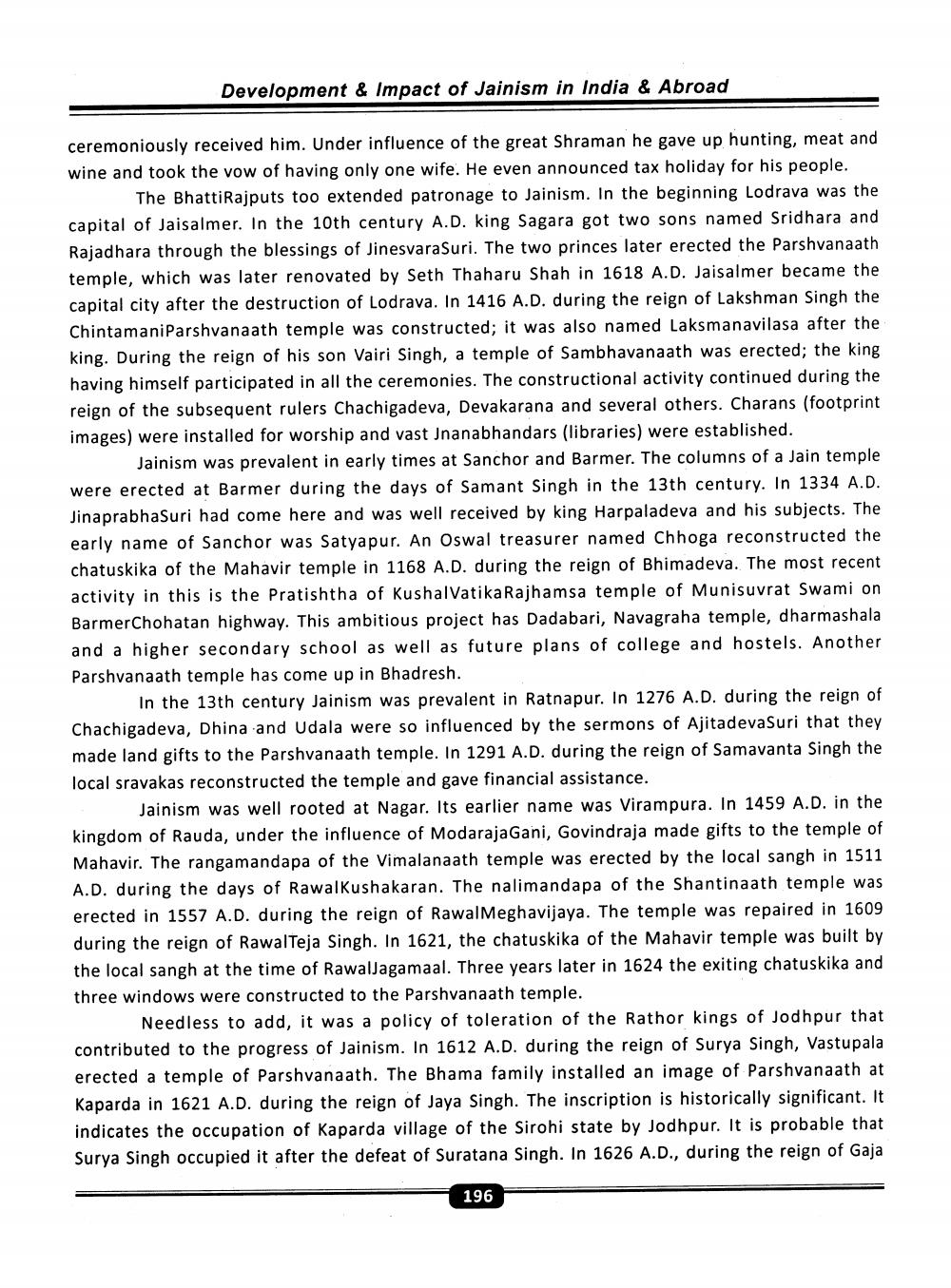________________
Development & Impact of Jainism in India & Abroad
ceremoniously received him. Under influence of the great Shraman he gave up hunting, meat and wine and took the vow of having only one wife. He even announced tax holiday for his people.
The Bhatti Rajputs too extended patronage to Jainism. In the beginning Lodrava was the capital of Jaisalmer. In the 10th century A.D. king Sagara got two sons named Sridhara and Rajadhara through the blessings of JinesvaraSuri. The two princes later erected the Parshvanaath temple, which was later renovated by Seth Thaharu Shah in 1618 A.D. Jaisalmer became the capital city after the destruction of Lodrava. In 1416 A.D. during the reign of Lakshman Singh the Chintamani Parshvanaath temple was constructed; it was also named Laksmanavilasa after the king. During the reign of his son Vairi Singh, a temple of Sambhavanaath was erected; the king having himself participated in all the ceremonies. The constructional activity continued during the reign of the subsequent rulers Chachigadeva, Devakarana and several others. Charans (footprint images) were installed for worship and vast Jnanabhandars (libraries) were established.
Jainism was prevalent in early times at Sanchor and Barmer. The columns of a Jain temple were erected at Barmer during the days of Samant Singh in the 13th century. In 1334 A.D. JinaprabhaSuri had come here and was well received by king Harpaladeva and his subjects. The early name of Sanchor was Satyapur. An Oswal treasurer named Chhoga reconstructed the chatuskika of the Mahavir temple in 1168 A.D. during the reign of Bhimadeva. The most recent activity in this is the Pratishtha of KushalVatika Rajhamsa temple of Munisuvrat Swami on Barmer Chohatan highway. This ambitious project has Dadabari, Navagraha temple, dharmashala and a higher secondary school as well as future plans of college and hostels. Another Parshvanaath temple has come up in Bhadresh.
In the 13th century Jainism was prevalent in Ratnapur. In 1276 A.D. during the reign of Chachigadeva, Dhina and Udala were so influenced by the sermons of AjitadevaSuri that they made land gifts to the Parshvanaath temple. In 1291 A.D. during the reign of Samavanta Singh the local sravakas reconstructed the temple and gave financial assistance.
Jainism was well rooted at Nagar. Its earlier name was Virampura. In 1459 A.D. in the kingdom of Rauda, under the influence of Modaraja Gani, Govindraja made gifts to the temple of Mahavir. The rangamandapa of the Vimalanaath temple was erected by the local sangh in 1511 A.D. during the days of Rawalkushakaran. The nalimandapa of the Shantinaath temple was erected in 1557 A.D. during the reign of RawalMeghavijaya. The temple was repaired in 1609 during the reign of RawalTeja Singh. In 1621, the chatuskika of the Mahavir temple was built by the local sangh at the time of RawalJagamaal. Three years later in 1624 the exiting chatuskika and three windows were constructed to the Parshvanaath temple.
Needless to add, it was a policy of toleration of the Rathor kings of Jodhpur that contributed to the progress of Jainism. In 1612 A.D. during the reign of Surya Singh, Vastupala erected a temple of Parshvanaath. The Bhama family installed an image of Parshvanaath at Kaparda in 1621 A.D. during the reign of Jaya Singh. The inscription is historically significant. It indicates the occupation of Kaparda village of the Sirohi state by Jodhpur. It is probable that Surya Singh occupied it after the defeat of Suratana Singh. In 1626 A.D., during the reign of Gaja
196




